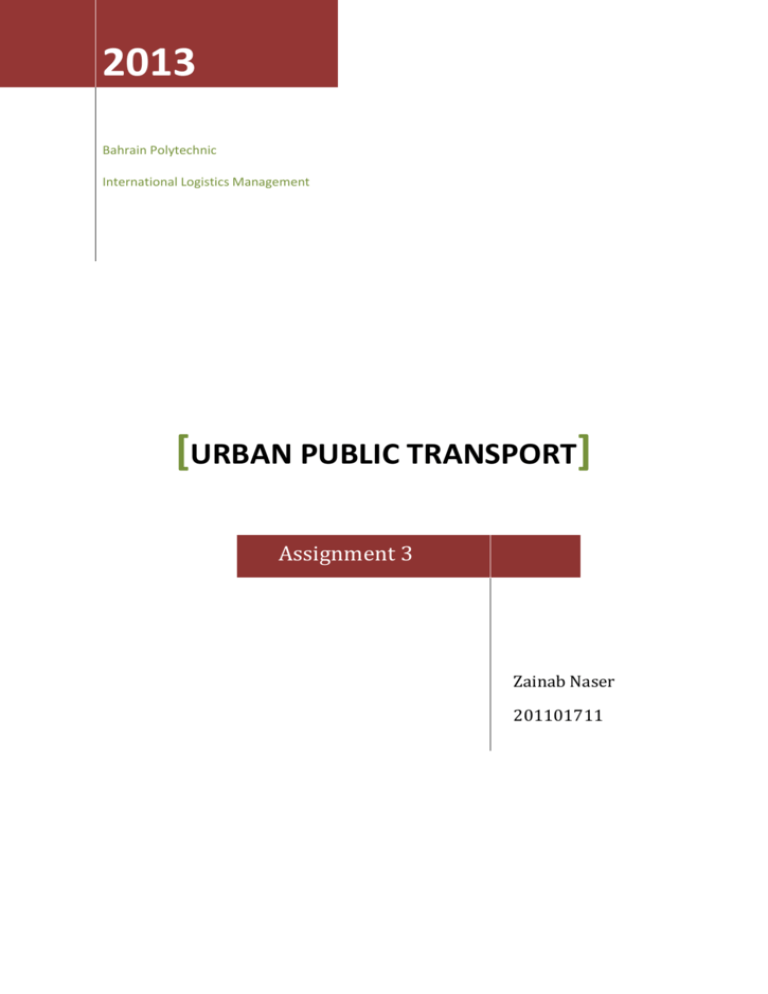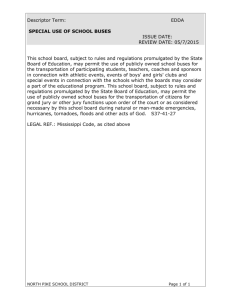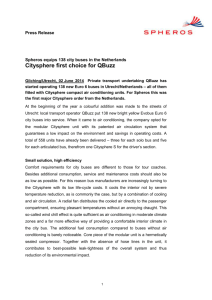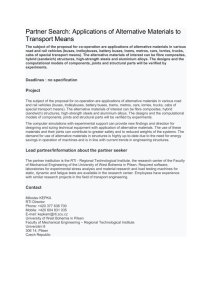Ownership and governance of urban public transport
advertisement

2013 Bahrain Polytechnic International Logistics Management [URBAN PUBLIC TRANSPORT] Assignment 3 Zainab Naser 201101711 Table of content: Contents Table of content: .......................................................................................................1 Table of figures: ........................................................................................................1 Introduction: ............................................................................................................2 Body: .......................................................................................................................2 Ownership and governance of urban public transport: ..................................................2 Finance of urban public transport and recovery the costs of operating them: ..................4 Responses to tourism and culture factors in urban public transports: ..............................5 Organizing and developing railway system: ..................................................................7 Table of figures: Figure 1 Map showing the routes of the future plan of railway network in Saudi Arabia........8 Figure 2 GCC railway route.............................................................................................9 Introduction: The aim of this report is to highlight the urban public transportations in the Gulf countries, comparing between them in four points. It will contain future view of railways in these six countries. Body: Ownership and governance of urban public transport: Bahrain Bahrain Public Transports are operated by private company called Cars Transport Corporation and it is regulated by the government regulations which are provided by the ministry of transportation. According to chief executive officer Ahmed Bin Hindi, the level of regulations is not very high and government needs to introduce new strict regulations and enforce them in public transport. He also said, CARS company is operating a fleet consists of 50 Mercedes buses which carry around 80 passenger and Toyota mini buses. There are 600 bus stops in Bahrain for the buses but many of them are not serviced because of unviable routes. The infrastructure of public transport is weak and the roads are not designed well. (Arabia, 2012), (Transport ministry website). UAE Public transportations are owned by Road and Transport Authority (RTA) which was formed in 2005 and governance by high level of regulations. It provides different services such as road users services and transport services. Moreover, it provides an advanced transport network based on high quality of infrastructure of roads and facilities like metro stations, to make the trips safe and smooth for passengers. RTA fleet consists of modern luxury buses with different sizes, advanced metro and taxis. (RTA website). Kuwait Kuwait Public Transport Company (KPTC) is responsible for operating public transport buses in Kuwait. It operates under the wise control of the government regulations and experienced national management. Furthermore, it provides an integrated transportation services due to the well-designed infrastructure, good roads and to its large transport fleet which consists of various types of buses. It has medium size buses with 40 seats, air conditioned and style curtains, another type of buses is touristic which it has 47 seats and equip pied with WC toilet and TV and the last type of buses are small size bus enough for 25 passenger. (KPTC website). Oman Public transportation in Oman is governance by National Transport Company which is owned by the government and it is regulated by the government regulations. In addition, the company operates fleet of Baiza buses which are colored white and orange, they are modern and air conditioned. These buses serve all main routes, loose and wide network of smaller byways in oman's cities. Another type of buses which are red and green large buses, they serve limited routes from point to point in all aroung Oman's cities. Seventeen long distance routes are provided for daily trips around Omen. The roads in Oman are good for transportations. However, some roads in Oman might be dangerous at night because of camels. (Hotel Travel website). Qatar Public Transportation in Qatar consists of fleet of taxis and bus system which is operated by government-owned transportation company called Mwasalat (Karwa). It operates 1800 taxis and 2500 buses which cover 35 routes around Qatar cities. However, these services are unreliable, ineffective and lack of safe because of the low level of governance and because of the lack of infrastructure. There are no strict rules on the drivers of the buses, most of bus drivers are illegal and drive crazy as Lana Khaleh, a student at Carnegie Mellon in Qatar said. (Mohammed, 2012). Saudi Arabia The owner ship of public transportation is a private company called Saudi Arabia Public Transport Company (SAPTCO) which is governance by government regulations. SAPTCO provide good quality of services that link 382 villages and cities in Saudi Arabia through 110 routes using different modes which are buses, train and metro. SAPTCO improved its passenger facilities and added new luxury buses to its fleet recently to provide safe and comfortable services. The infrastructure of the kingdom is good for the use of public transportations. The stations are in central location and they are equipped with prayer are and cafeteria. (SAPTCO website). Finance of urban public transport and recovery the costs of operating them: Bahrain The public transport in Bahrain is financed by the government. Because Bahrain is rich with oil, it uses some of oil revenues and aluminum business in operating public transports. It recovery the costs of operating by advertising for companies on the buses, fares of using parks in the city center and subsidizing. UAE The UAE government financed the public transport because of its oil revenues and the high economy. Also foreign investors helped in financing the public transport especially Dubai metro because Dubai is a famous tourist city and a lot of tourists use the metro. UAE recovery these costs from renting out retail outlets in stations, taxes or fares of some parking areas in malls and road tolls in business areas. To add more, it recovery some of the costs by the costs of advertisements in stations. Kuwait The government of Kuwait has financed and still financing public transports getting use of its good economy and oil revenues. It recovery the costs by the costs of tickets, advertising for companies in buses and in its website and by road tolls; roads within business areas. Oman Without the financed of the government, public transportations in Oman wouldn't exist. Like all GCC countries, Oman uses percentage of the oil revenues to build and develop public transports. It recovery these costs by the costs of using the buses, advertising on and in buses and by costs of road tolls. Qatar Even though Qatar is a rich country, it cuts a small percentage of its business and oil revenues to finance public transports. And because it doesn't cost much, it recovery the costs by the costs of the tickets and the fares of using some parking areas. Saudi Arabia The kingdom is the richest country of oil in the GCC region; it financed the public transportations using percentage of oil and natural gas business. Foreign investors also financed the train because it makes money each year in Al haj season. Saudi recovery the costs by advertising for companies on the buses and on the bus stop. Moreover, it recovery the costs also from issuing bonds for people in ministries and renting out retail outlets in train stations. Responses to tourism and culture factors in urban public transports: Bahrain Generally, the quality of public transport in Bahrain is low; the service of the buses is unreliable and the infrastructure is weak. People use to wait in bus stops for long time without knowing if the bus will come or no. Tourists cannot find schedules in the bus stops, most of the buses are dirty and without air conditioner. As a result, the tourists use taxis rather than buses but the taxis are expensive. The culture in Bahrain precludes the women of using public transport as she wears Abaya and Hijab and for other religion reasons. Another problem related to the culture is that Bahraini people refuse to use public buses when they are full with expats workers because of the smell and other reasons. UAE UAE provide advanced public transport services which encourage the tourists to use them. The buses and metro are clean, the seats are comfortable, they are air conditioned and it committed to schedules which are provided in the stations. In addition, tourists can find detailed information with two Arabic and English languages in the stations which it also has rooms to pray and close markets and other facilities. Moreover, UAE provides NOL cards, which are smart cards. People can buy it from stations; it helps them to move smoothly from one mode to another and to pay fast without any complexes. People in UAE use private cars because they used to it and as a matter of prestige but when the metro opened in Dubai, it encourages people either man or woman to use it as a modern type of transport. (RTA website). Kuwait As a result of the well-designed infrastructure, public transport services in Kuwait are good. Kuwait as a rich country trying to encourage tourists to use public transports by operating modern luxury buses which moves all around Kuwait cities committing to schedules. Tourists can easily find these schedules in the stations with more than one language. KPTC is providing special buses for the tourists to take them to the tourism areas. As a matter of prestige, most of Kuwaiti people refuse to use public transports. Women can use public transports without any culture problems. (KPTC website). Oman Oman policy to promote tourism is to have modern colored buses which each color has special routes. Buses are new, air conditioned and the cost of the ticket is cheap. There are buses special for the tourists to take them to the tourism areas. What encourages them more to use public buses is that there are no fixed taxi fares, tourist must negotiate the price. They are run the risk of paying more than the average fares. For the women in Oman, using public buses is not a problem for them even when they are alone because they are safe, the women usually set in the back seats of the buses and the men in front. (inter nation website). Qatar Qatar doesn’t really provide policies to encourage tourists or Qatari people to use public transports. The infrastructure of the public transport is weak and the services are unreliable, inefficient and not safe because of the crazy illegal drivers. All these are factors let the tourists walk away from using public transports. Public buses are difficult for Qatari women to use because they feel unsafe and because of culture restrictions. Even for expat women it is hard to use public buses as a Filipino woman called Anne Marie said. She said that she feels afraid of using public buses because only men use it. ( Mohammed, 2012). Saudi Arabia SAPTCO is a famous company in Saudi Arabia which it has a lot of advertisements to attract tourists to use. It provides safe comfortable services with low cost, the buses are with different sizes and they are new and air conditioned. About the train, the facilities which are provided with it have place to pray for men and women and cafeteria. Only tourist in the Kingdom use public transport because of the culture. Women are forbidden of using public transports because of culture restricts. Organizing and developing railway system: Bahrain Bahrain doesn't have railway system. However, the ministry of road planning planned for railway project working with Huda Fakhroo which is a design director. She said that the railway network will consist of monorail, Light Rail Transport (LRT) from Bahrain International airport to Bahrain mall, Bus Rapid Transport system (BRT) and trams. The network will cover 184.2km of the entire country using different colors for each route. UAE In 2009, United Arab Emirates opened an automated metro network in Dubai which have different routes underground and on elevated viaducts. It is the first metro in the GCC region and it is one of the world's safest metros. (Dubai Metro website) United Arab Emirates has made an expansion study to have metro in Abu Dhabi length 131km. This study came as a result of the Surface Transport Master Plan (STMP), it includes different types of transportations like: trains, metro, trams and Light Rail Transit (LRT). It is predicted that building this new services will be finished by 2030. (Abu Dhabi Metro). Kuwait Kuwait doesn’t have railways. In 2009, Kuwait lunched first metro rail project which it will be 171km in around Kuwait cities. Both government and private sectors are collaborating to implement this project. The ministry of communication and the Spanish training company Ingenieria and Consultoria de Tansporte (INECO) said that the project will enter execution step in 2010 and it expected to complete by 2016. This project is part of the GCC railway project. (railway-technology.com) Oman There are no main line railways in Oman, but there are some future plans to build rail network that connect all Omani's ports by rail. The first stage will start in 2015; the train railway will extend up to 3000km. In addition, this plan is to cement Oman's position as a logistics center in the GCC region. (Applegate, 2013). Qatar There are no railways in Qatar. However, in August 2009 Qatari Diar for estate investment made a contract with Deutsche Bahn of Germany to plan and build fast and integrated railway lines and underground networks in Qatar. This contract create company specialized in railways called Qatar Railways Development Company (QRDC) which it planned to have 345km metro lines. The construction planned to start in 2011 to finish in 2022. Saudi Arabia Saudi Railways Organization (SRO) operates a railway network which it length around 1380Km in Saudi Arabia and the passenger line in 449km. It is extended from King A.Aziz port in Dammam passing by some countries to the capital city of the kingdom, Riyadh. Because of the geographical expanse in the kingdom, Al-Shura Council made recommendations to expand the railway network around the kingdom's cities to connect the northern, western and eastern parts with the center area in the kingdom (look at figure1). As a result, the kingdom adopted a developed plan to expand the railway services. The plan consist of 3 projects; one of them assigned to the ministry of finance and two of them assigned to SRO. (SRO website). Figure 1 Map showing the routes of the future plan of railway network in Saudi Arabia The GCC railway: All GCC countries have agreed to have GCC railway which it will connect the six gulf countries together by 2116km rail for the first time, it will be an alternative for the plains or ships. Dr Ramiz Al Assar, World Bank resident adviser of the GCC said that the design of the railway network will cost nearly 200$ billion, this design will run down the Gulf coast from Kuwait to Saudi Arabia to the UAE to Oman and there will be branches to link Bahrain and Qatar (look at figure2). Moreover, network building will start in 2014 as it was planned and it is expected to finish in 2018 (Salama, 2013). Kingdom of Bahrain signed the Chairman of the Ministerial Committee for Services and Infrastructure to study all possible choices for the GCC railway plan in the kingdom. According to him, Bahrain is commitment to the implement of this project and the specialized authorities started putting work plan and time table. The ministry of works is studying two proposed routes for the GCC railway to provide report about the results. And he assured that this GCC railway will benefit Bahrain's economy. Figure 2 GCC railway route References: Websites: Agency, B. (2013). Gcc railwa'ys itinerary discussed . Retrieved from http://www.bna.bh/portal/en/news/587884 Applegate, S. (2013). Omani rail network. Retrieved from http://www.menarailnews.com/omani-rail-network-seen-alternative-shippingstraits-hormuz/ Arabia, T. (2012). Bahrain bus company plans expansion. Retrieved from http://www.tradearabia.com/news/IND_220196.html Authority, A. (n.d.). About metro. Retrieved from http://abu-dhabi-metro.com/aboutabu-dhabi-metro Company, K. (n.d.). Public transport services. Retrieved from http://www.kptc.com.kw/newenglish/ Company, K. (n.d.). Kuwait metro system, kuwait city, kuwait. Retrieved from http://www.railway-technology.com/projects/kuwaitmetrosystem/ Mohammed, O. (2012). Public transportation in qatar: Driving people crazy. Retrieved from http://www.dohastories.org/?p=106 Nations, I. (n.d.). Transportation in oman. Retrieved from http://www.internations.org/oman-expats/guide/living-in-oman15747/transportation-in-oman-3 Organization, S. (n.d.). Sadui railway. Retrieved from http://www.saudirailways.org/portal/page/portal/PRTS/root Road.&,Transport.Authourity. (n.d.). Transport services. Retrieved from www.rta.ae Road.&,Transport.Authourity. (n.d.). Dubai metro. Retrieved from http://dubaimetro.eu/ Salama, S. (2013). Gcc rail network to link all 6 gulf states by 2018. Retrieved from http://gulfnews.com/news/gulf/uae/traffic-transport/gcc-rail-network-to-linkall-6-gulf-states-by-2018-1.1248632 Saptco.Company. (n.d.). Integrated transportation solution. Retrieved from http://www.saptco.com.sa/mainsite/home.aspx?lang=en-US Travel, H. (n.d.). International transport. Retrieved from http://www.hoteltravel.com/oman/guides/transport.htm Pictures: Figure1: Map showing the routes of the future plan of railway network in Saudi Arabia. Retrieved from http://sar.com.sa/Default.aspx?tabid=63&language=en-GB Figure2: GCC railway route. Retrieved from http://www.constructionweekonline.com/pictures/3_GCC_Railway_map.jpg






